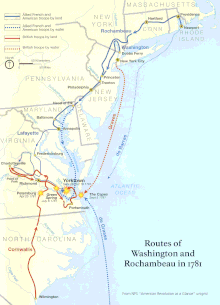
The Washington–Rochambeau Revolutionary Route is a 680-mile (1,090 km) National Historic Trail which describes a Continental Army campaign during the American War of Independence. It was designated in 2009, and has interpretative literature, signs and exhibits that describes France's role in the war.
The route passes by many sites of early United States history, and connects to routes such as the Underground Railroad, Plymouth to Hampton Roads, From St. Augustine to Hampton Roads and American Industry Tour.
Understand
editThe Kingdom of France was an important ally of the newly independent United States in their fight against their British Empire. French King Louis XVI dispatched commander Jean-Baptiste de Rochambeau with 5,300 soldiers and 450 officers to support the Continental Army. They made landfall in Newport (Rhode Island) on July 10, 1780.
A year later, in June 1781, they left Rhode Island, marched through Connecticut, and met up with George Washington's army in Dobbs Ferry.
Washington, Rochambeau, and their staffs arrived in Williamsburg (Virginia) on September 14, gathering the troops and supplies to begin the siege at Yorktown (Virginia), which came to be the last major land battle of the war.
Prepare
editThere are no fees for using the Washington–Rochambeau Revolutionary Route. Fees may be charged at some trail-related historic sites and interpretive facilities.
Get in
editThe trail begins in Newport, Rhode Island, which can be reached by car or by bus from Providence. The nearest major airports are T.F. Green Airport in Warwick and Boston Logan in Massachusetts. You might want to start your journey in Massachusetts anyway, as the northernmost end of the trail is in Boston, where Rochambeau's troops left the United States on Christmas 1782.
The southern end of the trail is in Yorktown, Virginia, which is best reached by car. Nearby Newport News has an airport, as do Richmond and Norfolk.
Of course it's also perfectly possible to just do a section of the trail, in which case you can start anywhere along the way. Washington, D.C., Baltimore, and Philadelphia have extensive transportation links.
Go
editYou can drive, bike, hike, or even navigate by boat on parts of the route taken by Revolutionary soldiers. Most of the maps available are tailored to drivers, though.
- 1 Newport (Rhode Island) – where French forces camped from 1780 to 1781
- 2 Providence (Rhode Island)
- 3 Lebanon (Connecticut) – Lebanon Green has historic buildings and Revolutionary War history.
- 4 Hartford (Connecticut)
- 5 Dobbs Ferry
- 6 Princeton – home to Princeton Battlefield, which includes the Thomas Clark House Museum (built 1772)
- 7 Trenton
- 8 Philadelphia – Washington and Rochambeau arrived here on August 30, 1781. The city's Independence National Historical Park includes several Revolution-era historic sites.
- 9 Baltimore
- 10 Annapolis – French and American soldiers sailed from here.
- 11 Williamsburg (Virginia) – including Colonial Williamsburg
- 12 Yorktown (Virginia) – site of the defeat of General Cornwallis, the beginning of the end of the Revolutionary War
Go next
edit- Star-Spangled Banner National Historic Trail—Commemorates the War of 1812, around the Chesapeake Bay

